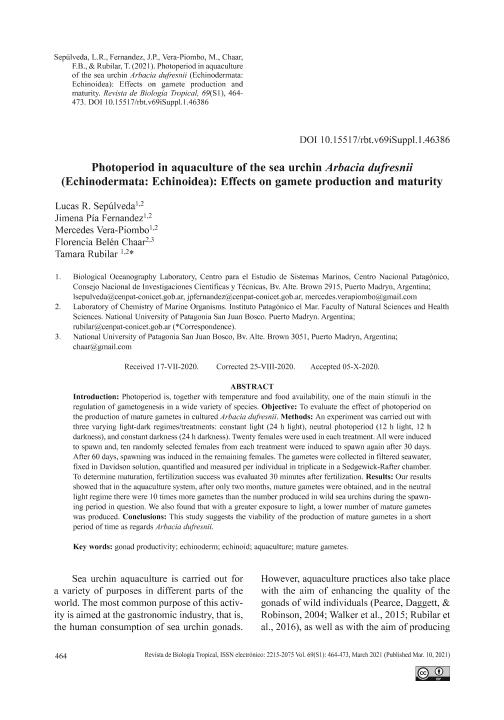Mostrar el registro sencillo del ítem
dc.contributor.author
Sepúlveda, Lucas Roberto

dc.contributor.author
Fernandez, Jimena Pía

dc.contributor.author
Vera Piombo, Mercedes

dc.contributor.author
Chaar, Florencia Belén

dc.contributor.author
Rubilar Panasiuk, Cynthia Tamara

dc.date.available
2022-08-26T17:13:14Z
dc.date.issued
2021-03
dc.identifier.citation
Sepúlveda, Lucas Roberto; Fernandez, Jimena Pía; Vera Piombo, Mercedes; Chaar, Florencia Belén; Rubilar Panasiuk, Cynthia Tamara; Photoperiod in aquaculture of the sea urchin Arbacia dufresnii (Echinodermata: Echinoidea): Effects on gamete production and maturity; Universidad de Costa Rica; Revista de Biología Tropical; 69; S1; 3-2021; 464-473
dc.identifier.issn
0034-7744
dc.identifier.uri
http://hdl.handle.net/11336/166701
dc.description.abstract
Introduction: Photoperiod is, together with temperature and food availability, one of the main stimuli in the regulation of gametogenesis in a wide variety of species. Objective: To evaluate the effect of photoperiod on the production of mature gametes in cultured Arbacia dufresnii. Methods: An experiment was carried out with three varying light-dark regimes/treatments: constant light (24 h light), neutral photoperiod (12 h light, 12 h darkness), and constant darkness (24 h darkness). Twenty females were used in each treatment. All were induced to spawn and, ten randomly selected females from each treatment were induced to spawn again after 30 days. After 60 days, spawning was induced in the remaining females. The gametes were collected in filtered seawater, fixed in Davidson solution, quantified and measured per individual in triplicate in a Sedgewick-Rafter chamber. To determine maturation, fertilization success was evaluated 30 minutes after fertilization. Results: Our results showed that in the aquaculture system, after only two months, mature gametes were obtained, and in the neutral light regime there were 10 times more gametes than the number produced in wild sea urchins during the spawn¬ing period in question. We also found that with a greater exposure to light, a lower number of mature gametes was produced. Conclusions: This study suggests the viability of the production of mature gametes in a short period of time as regards Arbacia dufresnii.
dc.format
application/pdf
dc.language.iso
eng
dc.publisher
Universidad de Costa Rica
dc.rights
info:eu-repo/semantics/openAccess
dc.rights.uri
https://creativecommons.org/licenses/by/2.5/ar/
dc.subject
GONAD PRODUCTIVITY
dc.subject
ECHINODERM
dc.subject
ECHINOID
dc.subject
AQUACULTURE
dc.subject
MATURE GAMETES
dc.subject.classification
Biología Reproductiva

dc.subject.classification
Ciencias Biológicas

dc.subject.classification
CIENCIAS NATURALES Y EXACTAS

dc.title
Photoperiod in aquaculture of the sea urchin Arbacia dufresnii (Echinodermata: Echinoidea): Effects on gamete production and maturity
dc.type
info:eu-repo/semantics/article
dc.type
info:ar-repo/semantics/artículo
dc.type
info:eu-repo/semantics/publishedVersion
dc.date.updated
2022-04-26T17:24:53Z
dc.identifier.eissn
2215-2075
dc.journal.volume
69
dc.journal.number
S1
dc.journal.pagination
464-473
dc.journal.pais
Costa Rica

dc.journal.ciudad
San José
dc.conicet.avisoEditorial
The journal is Full Open Access and is widely read where your article can have the highest real impact.
Copyright is openly shared by the authors and the journal; contents can be reproduced and reused by our readers, but source and copyright must correctly acknowledged, according to our CC BY 4.0 Open Access license.
Self-storage in preprint servers and repositories is allowed for all versions.
dc.description.fil
Fil: Sepúlveda, Lucas Roberto. Consejo Nacional de Investigaciones Científicas y Técnicas. Centro Científico Tecnológico Conicet - Centro Nacional Patagónico. Centro para el Estudio de Sistemas Marinos; Argentina. Universidad Nacional de la Patagonia "San Juan Bosco"; Argentina
dc.description.fil
Fil: Fernandez, Jimena Pía. Consejo Nacional de Investigaciones Científicas y Técnicas. Centro Científico Tecnológico Conicet - Centro Nacional Patagónico. Centro para el Estudio de Sistemas Marinos; Argentina. Universidad Nacional de la Patagonia "San Juan Bosco"; Argentina
dc.description.fil
Fil: Vera Piombo, Mercedes. Consejo Nacional de Investigaciones Científicas y Técnicas. Centro Científico Tecnológico Conicet - Centro Nacional Patagónico. Centro para el Estudio de Sistemas Marinos; Argentina. Universidad Nacional de la Patagonia "San Juan Bosco"; Argentina
dc.description.fil
Fil: Chaar, Florencia Belén. Universidad Nacional de la Patagonia "San Juan Bosco". Facultad de Ciencias Naturales - Sede Puerto Madryn. Instituto Patagónico del Mar; Argentina
dc.description.fil
Fil: Rubilar Panasiuk, Cynthia Tamara. Consejo Nacional de Investigaciones Científicas y Técnicas. Centro Científico Tecnológico Conicet - Centro Nacional Patagónico. Centro para el Estudio de Sistemas Marinos; Argentina. Universidad Nacional de la Patagonia "San Juan Bosco"; Argentina
dc.journal.title
Revista de Biología Tropical

dc.relation.alternativeid
info:eu-repo/semantics/altIdentifier/doi/http://dx.doi.org/10.15517/RBT.V69ISUPPL.1.46386
dc.relation.alternativeid
info:eu-repo/semantics/altIdentifier/url/https://revistas.ucr.ac.cr/index.php/rbt/article/view/46386/46125
Archivos asociados
